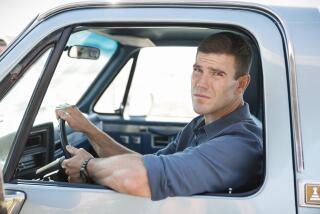Forensic Series Prove There’s Life After Death
- Share via
It began life this season on Friday nights before landing on volcanic Thursdays, opposite ABC’s reborn Regis Philbin and the heavyweights of NBC. Yet no wonder “CSI: Crime Scene Investigation” usually slices these hotshots like cadavers, despite early reservations about this smart and entertaining drama from at least one (blush) shortsighted critic.
Although following “Survivor II” in the CBS lineup doesn’t hurt, there’s more to “CSI’s” commercial success than that. Instead of dusting off the wormy bones of Jack Klugman’s maverick pathologist on “Quincy, M.E.,” senior guy Gil Grissom (William Petersen), tough Catherine Willows (Marg Helgenberger) and their fellow “CSI” operatives are Las Vegas crime scene investigators for a new millennium. They let science do most of the talking in a series that mingles gloss and gore with dark, spooky flair and intelligence.
Like any good crime hour, “CSI” exhales mystery, spending time sleuthing in the field, where the sun rarely seems to shine. Starring here, though, is the microscopic minutiae of its cutting-edge, sometimes goofy-sounding forensics. And at any point, ferociously centered Grissom can be found in front of a lab beaker or hunched over the slab, his eyes lasers, his brain absorbing arcane data while carving a corpse like a Thanksgiving turkey.
Breaking with the TV convention of elevating character over plot, “CSI” is fresh hemo for the globin. “We’re forensic scientists,” says Grissom’s brash young subordinate, Nick Stokes (George Eads). “Blood talks to us.”
And to more and more viewers at a time when prime time is in a forensics phase, from “CSI” and “Silent Witness”--a recent British series about a female pathologist deluxe shown on A&E--to; HBO’s string of ongoing “Autopsy” documentaries and Court TV’s nonfiction “Forensic Files.”
Exposed by none of these shows are disastrous forensic screw-ups by authorities like those that surfaced during O.J. Simpson’s criminal trial, tainting LAPD and prosecution credibility. Heroes are usually more bankable TV than heavies.
Once devoted exclusively to showing actual trials, Court TV is now embracing other crime fields in an effort to expand its audience while shoring up appeal to the 18-to-54 crowd.
Its “Forensic Files” resumes tonight with a half-hour recalling the use of forensic animation to identify the Florida hit-and-run driver whose truck slammed into five young girls in 1992, killing one.
Next Monday’s episode features the talents of a forensic anthropologist who helped finger the slayer of a food mart clerk by superimposing the suspect’s photo and body size over a poor-quality security video of the coldblooded shooting.
Although “Forensic Files” ably extends this specialized field to the masses and deploys its slick reenactments effectively, its jarring voice-over is the overcooked antithesis of the meticulous science it depicts.
Not so with HBO’s fascinating “Autopsy” documentaries, which are scheduled to be repeated later this year, with original episodes resuming in 2002. They include comments from pathologists (“As I opened her body, I smelled a very distinctive odor”) and others along with videotapes and photos of autopsies and crime scenes, some of them quite grisly.
These flashbacks to actual cases are narrated soberly, with quiet authority, by Marlene Sanders, a former CBS and ABC news correspondent. In for his share of sound bites, too, is Dr. Michael Baden, the noted director of forensic science for the New York State Police, who testified for the defense in O.J. Simpson’s criminal trial.
A recent “Autopsy” found DNA testers initially being fooled by a respected Canadian doctor after a female patient had accused him of drugging and raping her during an examination. Two blood tests later, his DNA still had not matched the sperm found in his accuser. Only later was it learned that the testers had unknowingly inserted their needles into a slender tube containing a patient’s blood that the guilty doctor had surgically implanted beside the vein in his arm, hoping to make himself DNA-proof. Later, DNA from his Chapstick did match.
Nearly as bizarre was an earlier episode showing forensic scientists learning a dead man’s identity with no clue beyond his severed hand, which had washed ashore in Florida. The hand’s outer layer of skin still had ridges. So one of the specialists removed it, inserted his own fingers, and from that obtained a usable print that attached a name to the hand’s owner.
The crime wasn’t murder. It turned out, instead, that the dead man’s grave had been invaded and his body mutilated as part of a funeral home owner’s voodoo scheme to undermine her competition.
These “Autopsy” hours and “CSI” both draw from the headlines. Sometimes from the same or similar headlines, it seems, for Thursday’s “CSI” had a funereal component, too, with a mortician admitting to Sara Sidel (Jorja Fox) he had deposited a body in a dumpster as a way of keeping up with the competition by cutting overhead.
Just as a recent “Autopsy” told of unhatched maggot eggs on a woman’s torso leading to the release of a man wrongly convicted of her murder, moreover, so did contents of maggots found with a body Thursday indicate to Grissom and Warrick Brown (Gary Dourdan) a young man’s possible cause of death in the desert.
And just as clearing up a killing in an “Autopsy” hinged on matching tooth prints to a bite mark, that also happened, albeit differently, in Thursday’s “CSI.”
The message here is that crime stories dominated by forensics need not be limited to one format. And that penetrating what “Autopsy” calls “the silence of the dead” is increasingly open to all comers.
*
“CSI” airs Thursday nights at 9 on CBS.
“Forensic Files” is shown weeknights at 9 on Court TV.
Howard Rosenberg’s column appears Mondays and Fridays. He can be contacted at [email protected].
More to Read
The complete guide to home viewing
Get Screen Gab for everything about the TV shows and streaming movies everyone’s talking about.
You may occasionally receive promotional content from the Los Angeles Times.






